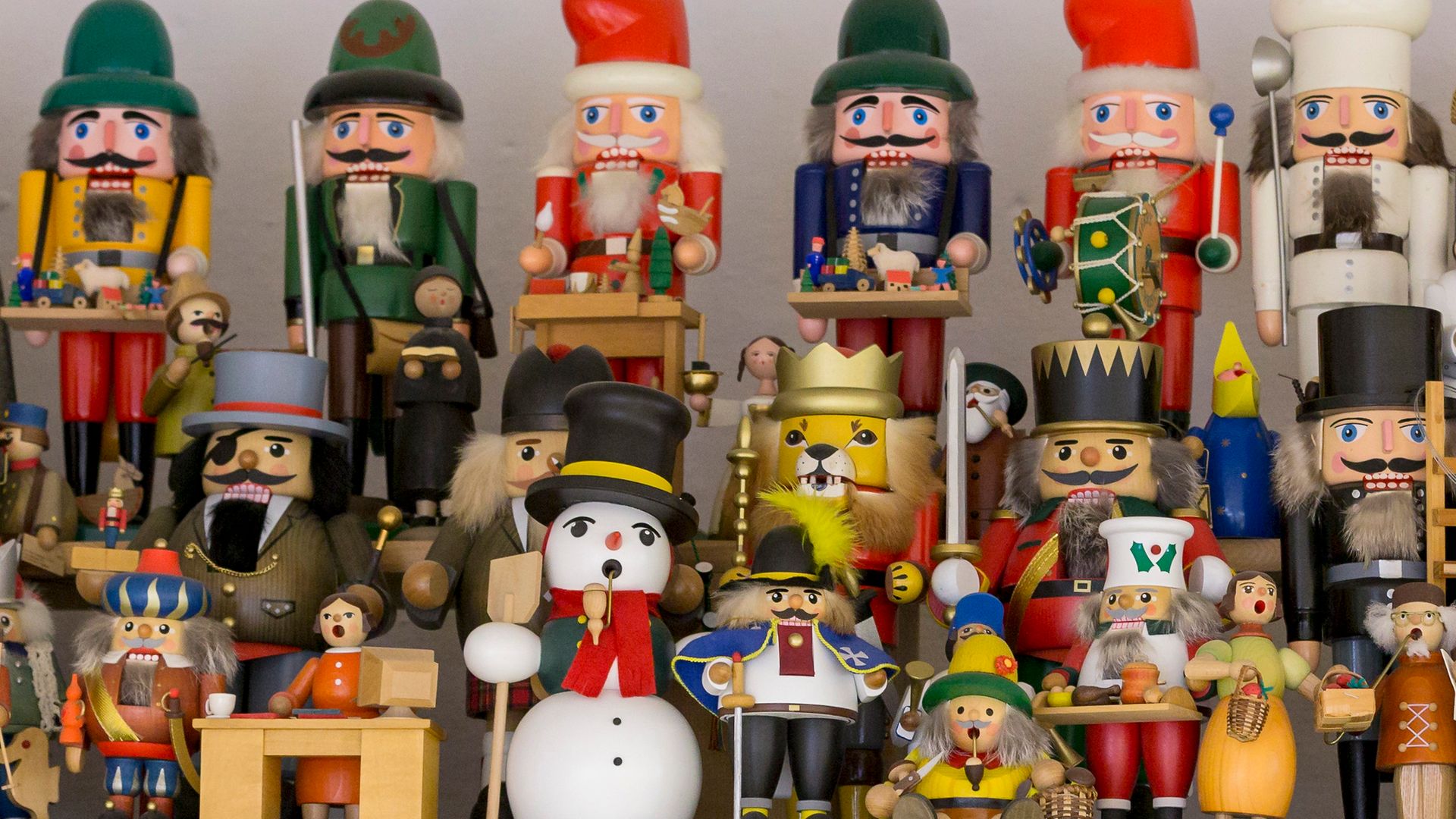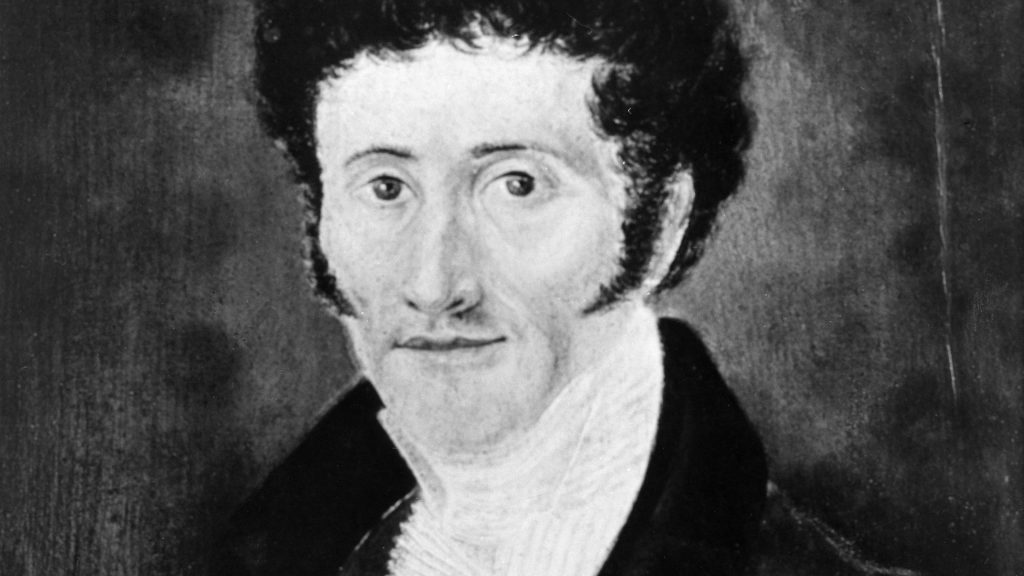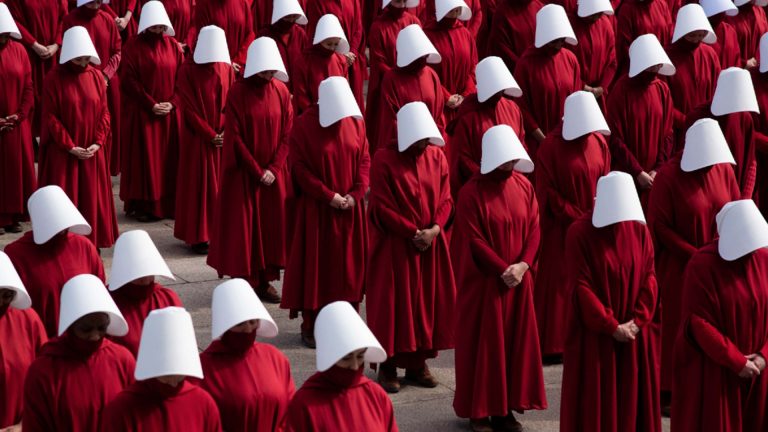
CHARLIE CONNELLY on an eerie German story and its remarkable creator.
If anyone does Christmas well it’s the Germans. Glühwein, Stollen, the Christmas market; they even convinced the world bringing a conifer indoors once a year and covering it in stuff was a pretty neat idea. When it comes to the December festivities it’s fair to say that Germany knocks it aus dem Park.
Perhaps inevitably we’ve absorbed a fair number of German traditions into our own Christmases. Most recently the distinctly Teutonic December markets have become a fixture in town centres across the country with their wooden cabins, spiced cider that’s delicious for about three sips before it becomes lukewarm and tart, and ‘artisan’ produce you wouldn’t look at twice unless it was a.) Christmas and b.) you’d just necked a paper cup of tart and lukewarm spiced cider.
Among the stalls these days you’ll usually find at least one selling another notable German Christmas tradition gradually taking hold here. You’ll see them lined up on shelves in appropriately regimental fashion, usually painted in a brightly-coloured braided Hussar’s uniform beneath an outsized head, tufty hair emerging from beneath a military cap or crown and a mouth that opens and closes, ostensibly for the cracking of nuts. These nutcracker dolls come in a range of sizes, from tiny hanging Christmas tree decoration to something so large it warrants an entry on the electoral register.
The obvious association of these figures is with Tchaikovsky’s ballet The Nutcracker, attending a performance of which is another Christmas tradition for many, but the nutcracker dolls owe their yuletide profile in no small part to one of the greatest European writers of the Romantic era.
The nutcracker figure first appeared in the form we know today towards the end of the 17th century in the Erzgebirge region of the Ore mountains in what are now the borderlands of Germany and the Czech Republic. It was a region rich in gold, silver and tin, mined for centuries, with the miners also earning a considerable reputation for the quality of their woodcarving.
The mountain winters were long and dark and the people would spend much of their time whittling and carving, creating meticulously realised figures to give as gifts, many of them doubling up as nutcrackers.
As the wars that criss-crossed Europe brought varying degrees of disruption and hardship, the figures developed a satirical purpose, taking the forms of barons, kings and soldiers, giving people a feeling of satisfaction that their nuts were being cracked on demand between the teeth of people who were otherwise making their lives much harder than they needed to be.
The template figure of today’s nutcracker is largely the creation of Friedrich Wilhelm Füchtner, a woodturner from Seiffen who in the 1870s made the first mass-produced figures. Füchtner creations are still sought after today as a fifth generation of the family continues the craft, each doll containing around 130 separate parts.
But the key source of the nutcracker tradition, from its place at the heart of a German Christmas to the glockenspiel ring of the Dance of the Sugar Plum Fairy on a ballet stage, is a short story, Nussknacker und Mausekönig (‘The Nutcracker and the Mouse King’) first published in 1816 by E.T.A. Hoffmann.
He’s not as much of a household name as he used to be but in the early years of the 19th century Hoffmann was one of the most popular authors in Europe, widely translated and mentioned in the same breath as Lord Byron and Sir Walter Scott. Honoré de Balzac called him ”the poet of what doesn’t appear to exist, yet has life”, Jacques Offenbach adapted some of his short stories for his opera Tales of Hoffmann and he was as popular in Russia as he was in Germany, becoming a key influence on Gogol and Dostoevsky in particular.
He wrote eight operas, established himself as a prominent music critic of the Romantic era and even found time to be a noted orchestral conductor, but it’s for his 49 short stories and two novels that Hoffmann is best remembered. His body of work revolutionised German Romanticism, the Gothic and the wider horror genre across Europe and the world, and strong traces of his influence can be found today in everything from the ghost stories of M.R. James to this year’s lockdown hit British horror Zoom-séance film Host.
Fearing the growing Enlightenment rationalism taking hold in Europe was stifling the creative imagination, Hoffmann’s stories became ever more innovative and esoteric. Crucially he was the first to bring the fantastical and supernatural into the everyday world.
Before him the spooky and unexplained existed almost exclusively in fairy tales and folk stories that were set in magical lands or in the distant past of ‘once upon a time’. Hoffmann’s stories brought the uncanny to your town, to your street, even into your home.
Mysterious events and roving spirits were no longer restricted to far-off castles in far-off lands in centuries past, they could be tapping at your window, pulling at your coverlet or bringing harmless objects to life around you in the dark.

One of his favourite fictional devices was the clockwork automaton, employed most notably in the guise of Olimpia the life size clockwork doll with whom the narrator falls in love in The Sandman, a story so unsettling it prompted Sigmund Freud to write his seminal essay The Uncanny. In stories such as these Hoffmann crept through an undefinable zone in which reality, dreams and madness mixed, leaving the reader unsure of their own interpretation, fostering a tangible sense of unease rarely equalled in fiction.
Hoffmann’s life was almost as chaotic as the world he created for his stories. After graduating from university, he took a job with the Prussian civil service that took him to various provincial backwaters where he set about drinking heavily and embarking on a number of extramarital affairs.
A gifted composer – the ‘A’ in E.T.A. stood for ‘Amadeus’, a name he added himself in tribute to Mozart – in 1808 Hoffmann was appointed musical director at the opera house in Bamberg where he wrote one of the first detailed reviews of Beethoven’s Fifth Symphony. It was a piece of writing hugely influential at the time, one appreciated by the composer himself and one valued even today by Beethoven scholars. But what made it especially remarkable was that Hoffmann wrote his review never having heard so much as a note – he’d just read the orchestral score.
In 1814, after years of uncertainty caused by war and Napoleonic expansionism, he took up a senior civil service post as a judge in Berlin where he became a regular at the Lutter und Wegner restaurant, smoking and drinking late into the night with writers, artists and musicians.
It was in Berlin, encouraged by his new acquaintances, that he published most of his fiction, notably his novels Die Elixir des Teufels (‘The Devil’s Elixir’) and Lebensansichten des Katers Murr, purportedly the memoir of an opinionated cat that was published in English as ‘The Life and Opinions of Tomcat Murr’.
The satirical nature of his writing would regularly land Hoffmann in hot water and at his death in 1822 at the age of 46 when a combination of fast living and syphilis finally caught up with him, he was being sued for defamation by the district commissioner.
For all his contemporary success Hoffmann soon fell out of fashion and by the end of the century had been almost forgotten. It was Three Musketeers author Alexandre Dumas who kept his The Nutcracker and the Mouse King alive, rewriting it in 1845 into something a little less dark than Hoffmann’s unnerving original.
It was this version that Tchaikovsky orchestrated in 1892, paving the way for the story of the Nutcracker to become embedded in European culture.
His original story The Nutcracker and the Mouse King is the very essence of Hoffmann, turning the familiar into something deeply unsettling and making the reader suspend their rationality to doubt even their own basic assumptions.
The story begins on Christmas Eve and with brother and sister Frederic and Maria speculating on what gifts their mysterious godfather Drosselmeier might have brought them. When the children are admitted to the room containing their Christmas presents they find the old clockmaker has created a golden castle for them with figures moving in and out of rooms and through doors apparently of their own accord. As part of the display there is also a nutcracker in the braided uniform of a Hussar whose teeth were designed to crack walnuts.
That night the Nutcracker and the children’s toys come to life around Maria, the wooden figure leading a regiment of soldiers and other toys in a fearsome battle against hordes of green-eyed mice that emerge from behind skirting boards and under floorboards.
Under the command of the Mouse King, a seven-headed creature with a crown on each head, the mice are beaten back by cannonades of sugar plums tearing into their ranks and the toys seem to be winning, but gradually the rodents gain the upper hand and, as a terrified Maria looks on, close in on the Nutcracker himself.
Maria picks up a shoe and hurls it at the mice who scatter, sparing the Nutcracker from being killed. Maria faints, falls into a glass case and cuts her arm badly, rendering her bedbound and the story of the battling mice and toys put down to injury-related delirium.
As she sleeps she hears the Mouse King whispering to her, threatening the Nutcracker, who subsequently prevails upon her for a sword with which to kill the leader of his enemies. Securing one from one of Frederic’s toy soldiers, the following night Maria hears a noise at her bedroom door.
“The little Nutcracker stood without, with a bloody sword in his right hand, and a wax taper in his left. As soon as he saw Maria, he bent down on one knee, and said: ‘You, oh lady, you alone it was, that filled me with knightly courage, and gave this arm strength to contend with the presumptuous foe who dared to disturb your slumber. The treacherous Mouse King is overcome; he lies bathed in his blood. Scorn not to receive the tokens of victory from a knight who will remain devoted to your service until death’.”
The Nutcracker escorts her through a secret door to a magical land of sweets and sugar plums and on to what turns out to be his castle, where Maria falls asleep and wakes up in her own bed where nobody will believe her story.
A few weeks later the Nutcracker arrives at the house in the guise of Drosselmaier’s nephew, pledging undying love. A year and a day later he returns to escort Maria to his kingdom where they marry and she becomes queen.
This is the pinnacle of Hoffmann’s philosophy. Maria, frustrated by the closed minds of her family, escapes into a world of inexplicable wonder entirely of her own volition. She’s not captured or kidnapped; she chooses to leave this stifling world of reason and rationality in order to embrace wonder and love.
It’s the kind of attitude that lies at the heart of the magic of Christmas, or at least in the tidied up, less eerie version into which the Nutcracker has been absorbed. In Hoffmann’s world, meanwhile, there are seven-headed mice kings under your floorboards and the sugar plum fairy doesn’t dance.
This Christmas, may your days be merry and bright. Can’t vouch for your nights, though.
The Nutcracker and the Mouse King by E.T.A. Hoffmann and The Tale of the Nutcracker by Alexandre Dumas are published together in one volume by Penguin Classics, price £12.25
FIVE GREAT CHRISTMAS BOOKS
VILLAGE CHRISTMAS AND OTHER NOTES ON THE ENGLISH YEAR
Laurie Lee (Penguin Classics, £7.99)
Laurie Lee left his childhood village in the Cotswolds’ Slad Valley at 19 but it remained with him until in advancing age after years of wandering, he came home. This collection brings to life the sights, sounds, landscapes and traditions of his locale, from carol singing in the snow at Christmas to ancient rituals on May Day. A moving, lyrical portrait of England through the changing years and seasons.
LETTERS FROM FATHER CHRISTMAS
J.R.R. Tolkien (HarperCollins, £20)
It’s 100 years this year since the Lord of the Rings author wrote his first letter from Father Christmas to his children. Every December until the 1940s an envelope postmarked the North Pole would arrive containing a letter in strange spidery handwriting, usually with a drawing, from Father Christmas himself. This beautifully produced book marks the centenary with an introduction by Baillie Tolkien, widow of the writer’s son Christopher who died earlier this year.
CHRISTMAS AT COLD COMFORT FARM
Stella Gibbons (Vintage, £8.99)
A collection of Christmas stories that tell of a typical yuletide at the eponymous farm: unsuitable presents, unpleasant insertions into the pudding and Aunt Ada Doom ordering Amos to carve the turkey, with a jovial, “Ay, would it were a vulture, ’twere more fitting”. This 2011 edition comes with an introduction by Alexander McCall Smith.
CHRISTMAS PUDDING
Nancy Mitford (Penguin, £8.99)
Nancy Mitford is long overdue a revival, and this festive-themed novel describing Lady Bobbin’s Christmas party is as good comic masterpiece to get the ball rolling as any. Guests include formidable daughter Philadelphia and an author whose po-faced debut novel has just been declared the funniest book of the year. Add in some booze and high jinks and you’ve an unforgettable Christmas on your hands.
A TREASURY OF AFRICAN-AMERICAN CHRISTMAS STORIES
Edited by Bettye Collier-Thomas (Beacon, £15.99)
Featuring writers such as Pauline Hopkins, W.E.B. Du Bois and Langston Hughes, this is a beautifully curated collection of prose and verse relating the Christmas experience through African American eyes. With names familiar and new, these writers, poets, journalists and activists provide a fresh and invigorating perspective on the holiday season.










